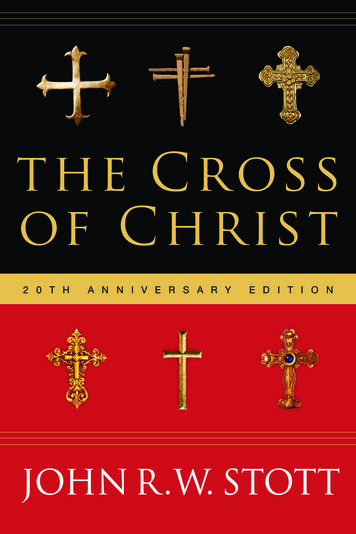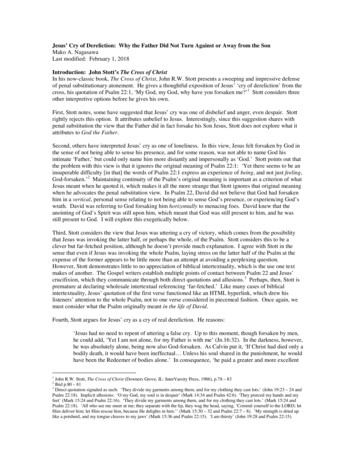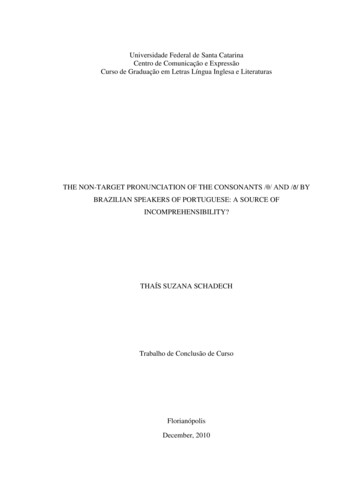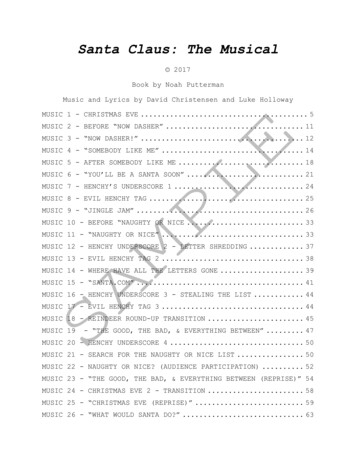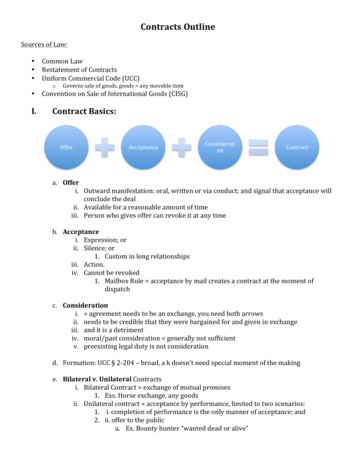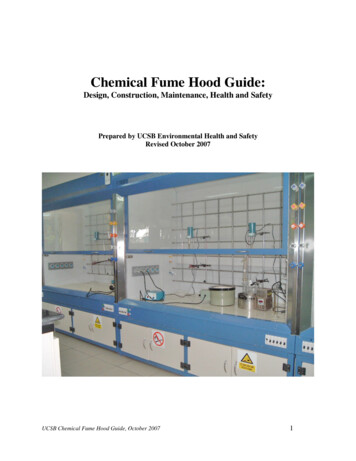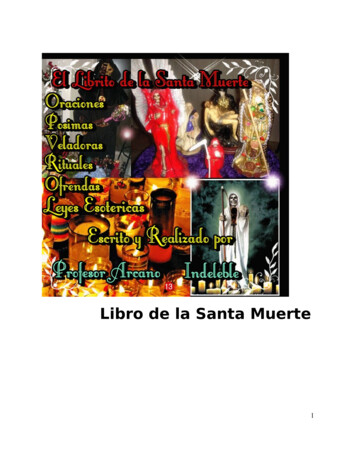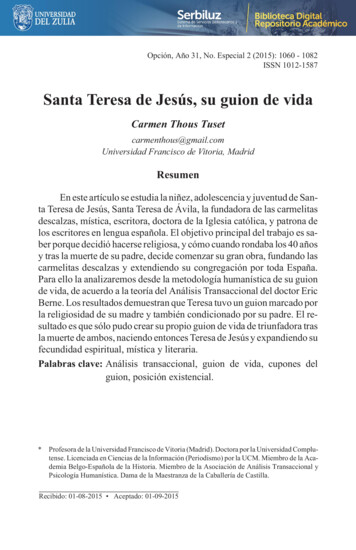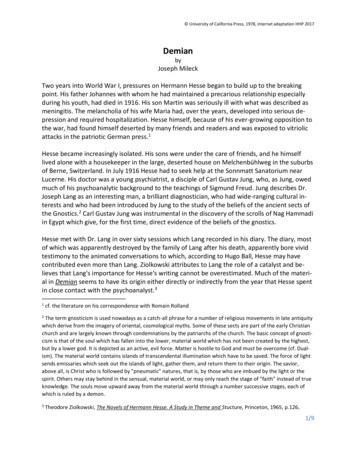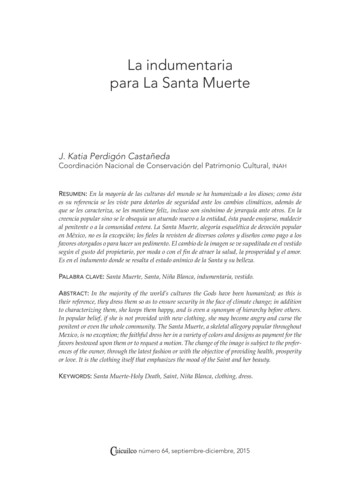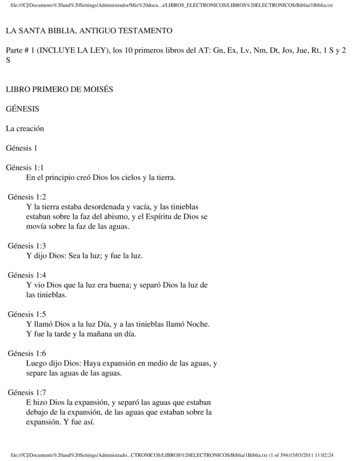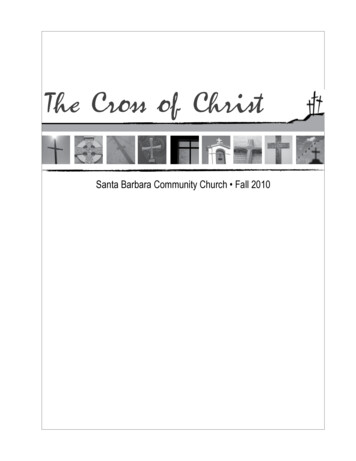
Transcription
The Cross of ChristSanta Barbara Community Church Fall 2010
The Cross of ChristTable of Contents & Study ScheduleSTUDY NO.TITLE/TEXTPAGETEACHING DATE*Study OneThe Lamb Who Was Slain 1Revelation 4–59/26/10Study TwoThe Cross Anticipated: The Suffering Servant 7Isaiah 5310/3/10Study ThreeThe Crucified Messiah 15Matthew 26–2710/10/10Study FourSuffering Servant/Triumphant King 23Mark 14–1510/17/10Study FiveThe Compassionate Savior 31Luke 22:1—23:5610/24/10Study SixMajestic King, Glorious Substitute 39John 18:1—19:4210/31/10Study SevenAdopted and Blood Bought 45Ephesians 1:3-1411/7/10Study EightA Justification, Redemption and Propitiation 51Romans 3:21-2611/14/10Study NineDaring to Draw Near 59Hebrews 10:1-2511/21/10*Sunday teaching precedes homegroup discussion for each study.About This StudyThis study was written by Reed Jolley and proofread by Nikki Knott, Bonnie Fearer, Susi Lamoutte andSteve Jolley. Thanks to all, but credit where credit is due. In large part, this study is but a book reporton several sections of Derek Tidball’s book, The Message of the Cross, IVP, 2001, hereafter referred toas Tidball in the various citations. The other book that was most helpful in preparing this study is JohnStott’s magisterial The Cross of Christ, IVP, 1986, hereafter referred to as Stott in the various citations.The purpose of this study is to guide us into the Scriptures. As we move ahead together as a churchcommunity, let us make sure that first, we study the Scriptures. The Bible is God’s word and, as theApostle said, it is for our encouragement and correction. Accordingly, let us make sure we study theBible, eagerly and expectantly. The pages of this study guide are not an end in itself, but are intendedto prompt us to look into the Book of all books so that we may worship the King of all kings.
Study OneThe Lamb Who Was SlainRevelation 4–5And I, when I came to you, brothers, did not come proclaiming to you the testimonyof God with lofty speech or wisdom. For I decided to know nothing among you exceptJesus Christ and him crucified.1 Corinthians 2:1-2It is no stretch to say that Christianity is areligion of the cross. A cross usually adornsthe place of Christian worship. We wearcrosses of gold as jewelry and tattoo them intoour skin. Preachers teach about the crossand the congregation sings about the sameinstrument of death.When I survey the wondrous crossOn which the Prince of glory died,My richest gain I count but loss,And pour contempt on all my pride.Forbid it Lord, that I should boastSave in the cross of Christ my GodAll the vain things that charm me most,I sacrifice them to his blood.The cross of Christ is at the center of everything. The cross is the fulcrum of history, thesupreme demonstration of the justice and glory of God. The cross of Christ is the centerof gravity for the whole universe. As William Dembski writes, God’s goodness in creationbegins and ends with the cross of Christ. The cross is God’s answer to the problemof suffering and evil even as it is the supreme demonstration of God’s love. The crosswas planned by God before time began (1 Corinthians 2:7) and will be celebrated whenearthly history has come to an end (Revelation 5:13). Indeed, the place of the cross inthe understanding of the believer cannot be overestimated. The cynic George BernardShaw was not far off the mark when he quipped that Christians should rename themselvesCrosstians.The witness of various theologians and Christian leaders bears witness to the centrality ofthe cross in the Christian faith. The End of Christianity: Finding a Good God in an Evil World, 2009, p. 14.study one
The Cross of Christ Eighteenth-century Cambridge pastor Charles Simeon called Christianity the religion of asinner at the foot of the cross.J. C. Ryle, Bishop of Liverpool said that without the cross your religion is a heaven withouta sun, an arch without a keystone, a compass without a needle, a clock without a spring orweights, a lamp without oil.Charles Spurgeon, eminent 19th century preacher in London said, The cross is the centre ofour system.G. Campbell Morgan, 20th century pastor of Westminster Chapel, said that every livingexperience of Christianity begins at the cross. As British journalist Malcolm Muggeridge observed regarding the death of Jesus,It was manifestly the most famous death in history. No other death has aroused onehundredth par of the interest, or been remembered with one-hundredth par of theintensity and concern.Over the next nine weeks we are going to study the cross of Christ. We are going to ponderthe meaning of a particular death on a particular tree at a particular moment in history.We will tip-toe around the cross, realizing that we walk on holy ground. We will probe themeaning of the cross, realizing that we will never come close to plumbing the depths of itssignificance. And we will begin at the end. Our first look at the cross comes from the lastbook of the Bible, the Revelation of John.In Revelation 4-5 the scene is in heaven, the setting is the climax of the whole story of theBible. The problem in this brief section is finding someone worthy to open the seals of thescroll. No one, it seems, is able to open the scroll! The situation is so calamitous that Johnweeps loudly.Before going on in this study, read Revelation 4-5. Note, this study will concentrate onchapter 5 but chapter 4 sets the stage for our study. Don’t let the imagery of this shortsection (25 verses in all) throw you. The apostle John is recording a vision given to him byGod. As such, the reader is invited to look over John’s shoulder and see what John saw. Atthe outset, don’t worry about interpreting John’s vision. Read and observe with him. Makenotes of what stands out, of what is clear and un-clear. Keep the following questions in mindas you read. The Apostle John is the author of Revelation. What do you think he is trying tocommunicate with the reader in these verses? These quotes and others are found in Tidball, p. 22.study one
If you were to paint these verses on a canvas, what would the painting look like?Either draw Revelation 4-5 or describe the same section of John’s vision.Notes on your reading:ClearUnclearWhen we begin reading Revelation 5, the immediate problem is that no one is worthy toopen the scroll and break its seals. As is the case in virtually every verse of Revelation,interpretations of what the scroll signifies differ. Nevertheless, most would agree with thenote in the ESV Study Bible which says,In a broader sense, the scroll contains God’s purposes for history, but its seven sealsprevent the full disclosure and enactment of its contents.As one commentator on Revelation put it, the scroll containsGod’s redemptive plan, foreshadowed in the Old Testament, by which he means toassert his sovereignty over a sinful world and so achieve the purpose of his creation. With the above quotation in mind, look over Revelation 5 once again. What is the crucialevent in all history that gives the rest of the parts their meaning? George Caird, The Revelation of St. John the Divine, 1966, p. 72.study one
The Cross of Christ The Lamb (5:1-14)At the center of John’s vision in Revelation 5 is a lamb. This is, perhaps, John’s favoriteimage of the Messiah in this book. There are 29 references to ‘the Lamb’ in the book and allbut one refer to Jesus. (Tidball, p. 305) The drama of the whole book leads the reader tothe triumph of the Lamb and the consummation of history.While the Lamb is shown to manifest wrath and mete out judgment (6:16; 14:10;17:14), he is usually seen as the focus of the worship of the believing community.Standing in the control centre of the universe, worshippers rejoice in the salvation hehas won for them (7:9-19; 15:3), look to him for protection and guidance (7:17; 14:4),keenly anticipate his wedding supper as he is joined for ever to his bride, the church(19:7-9), and confidently predict his future reign at the center of the new creation(21:1–22:6). (Tidball, p. 306)Revelation 5:6 is the first reference to the Lamb in John’s book. Consider what we learnabout the Lamb in these verses. Look for the following:5:5 His titles: What two titles does John apply to the Lamb? For the Old Testamentbackground see Genesis 49:9-10 and Isaiah 11:1.5:6 His countenance: What does the Lamb look like?5:6 His posture: What is the Lamb’s posture? What is the significance of this?5:6 His features: This is no ordinary lamb. What do you think this description means?5:8-10 His achievement: Read over these verses carefully. Much is being made of thisLamb in this section of Revelation. Why? What did the Lamb accomplish? And how wasthis accomplished? Revelation 13:11 contains the exception where the beast of the earth has lamb-like horns.study one
Notice especially the universality of the Lamb’s achievement. For whom was the Lamb’sblood shed? For what purpose (5:10) was his blood shed?Describe what this looks like in your life. What has Jesus ransomed you from? Where hashe taken you? What has he made you? Be specific.Compare Paul’s words to the Ephesian elders in Acts 20:28. See also 1 Peter 1:18-20and 1 Corinthians 6:19-20. The message in each of these verses is that our relation withGod is blood-bought. How should this truth affect us? How should this truth affect ourunderstanding of the church?4:1-5:14 His Worship Look over both of these chapters again. Refer back to your drawing(if you made one) of the chapters. What we find is the whole universe, sitting in a circle,worshipping the Lamb! Everyone is there: the twenty-four elders, the four living creatures,the myriads of angels, and, finally, every creature in heaven and on earth and under theearth and in the sea, and all that is in them. Everyone and everything is focused on theLamb. What are the multitudes saying? See 5:13.study one
The Cross of Christ Tidball points out the obvious!The ever-widening circles of worshippers tell us that at the heart of our universe theachievement of the cross is celebrated by all that is best, all that is angelic and allthat is human; no part of our created universe fails to join in the new song declaringthe worthiness of the Lamb who was slain. (Tidball, p. 316)Spend time as a homegroup declaring the worthiness of the Lamb. Add your voices to thischorus of eternal praise. Practice now doing what you will be doing for eternity if you aresaved by his cross.As we conclude our study, we should not fail to note the supreme contradiction in John’svision. Here we meet Jesus who is both the Lion of the tribe of Judah (5:5) and the Lambwho was slain. In the 18th century the famous preacher Jonathan Edwards preacheda sermon on Revelation 5 titled, The Excellency of Christ. His words on this supremecontradiction are timeless.In Jesus Christ meet infinite highness and infinite condescension; infinite justice andinfinite grace; infinite glory and lowest humility; infinite majesty and transcendentmeekness; deepest reverence toward God and equality with God; worthiness ofgood and the greatest patience under the suffering of evil; a great spirit of obedienceand supreme dominion over heaven and earth; absolute sovereignty and perfectresignation; self-sufficiency and an entire trust and reliance on God. He is the lionwho is the lamb. Sermon Notes This quotation is paraphrased somewhat and comes from various parts of Edwards’ sermon. The entiresermon is readily available on the internet.study one
Study TwoThe Cross Anticipated: TheSuffering ServantIsaiah 53If I were asked the secret of the attractivepower of the crucified Savior, I shouldanswer that it is invincible love. The onlycrime that could be laid to Jesus’ chargewas that of loving beyond all reason andbeyond all bound—loving as none everloved before.Charles SpurgeonSin is a biblical code-word for crud. It refers toour failure to be perfect. Literally the word sinmeans, to miss the mark. It is not too muchto say that sin is the fundamental problem ofevery thing and every one. Sin affects our environment, our politics, our economics, and oursocial relations. At the top of the list is the truth that sin alienates each one of us from ourcreator.[Y]our iniquities have made a separation between you and your God, and your sinshave hidden his face from you so that he does not hear.Isaiah 59:2The breach between sinful men and women and their God is profound. God’s majesticholiness coupled with his divine righteousness make fellowship with sin-infected creaturesimpossible. If we find ourselves thinking, Why can’t God simply forgive me the way I forgivemy spouse from time to time? we fail to appreciate either the gravity of our own sinfulness orthe purity of God’s being. As Carnegie Simpson writes,Forgiveness is to man the plainest of duties; to God it is the profoundest ofproblems. The cross of Christ is God’s final solution to the problem of sin. But the cross wasn’t an ideafirst heard of in the time of Jesus. The pages of the Bible anticipate the cross almost fromthe beginning. When Adam and Eve sin in the Garden, God curses the serpent, the tempter,saying that one day he (the serpent) will be destroyed by a coming messiah(Genesis 3:15 ). Cited in Stott, p. 88. This promise is very vague and disguised, but it looks forward to the cross.study two
The Cross of Christ Abraham’s near sacrifice of his son, Isaac, anticipates the time when God thefather will sacrifice his son (Genesis 22:1-19). The Passover in Egypt clearly looks forward to a slain lamb which is substitutedfor the people’s sins (Exodus 12:1-51). The Day of Atonement, observed annually by the priests of Israel, looked forwardto a coming redeemer and substitute (Leviticus 16:1-34).While these passages, among many others, anticipate the cross of Christ, none is moregraphic and pointed as what we find in Isaiah 52:13–53
The other book that was most helpful in preparing this study is John Stott’s magisterial The Cross of Christ, IVP, 1986, hereafter referred to as Stott in the various citations. The purpose of this study is to guide us into the Scriptures. As we move ahead together as a church community, let us make sure that first, we study the Scriptures.The Bible is God’s word and, as the Apostle said .
